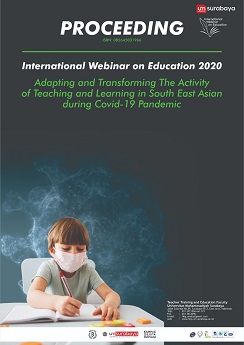The influence of online learning platform models during the COVID-19 outbreak on college student satisfaction levels in Southeast Sulawesi
Abstrak
Abstract.
During the COVID-19 outbreak, we had to do physical distancing, so that all
universities in Indonesia conducted online class programs. This research focuses on the segmentation of college student assessment in choosing online learning platforms and in the context of their satisfaction. An empirical survey was conducted on 295 college students who were taught using various online learning platforms through online surveys. The results showed the selection and use of learning platforms significantly influence the level of college student satisfaction. The use of online learning platforms with a combination of Zoom + Google Classroom + WhatsApp application (model 1) becomes a very dominant choice used by college students in online learning when compared to other models
Referensi
M. Burns, ―Finding The eLearning Platform Of Your Dreams,‖ 2016.https://elearningindustry.com/finding-elearning-platform-dreams (accessed May 23, 2020).
D. Benta, G. Bologa, and I. Dzitac, ―E-learning platforms in higher education. Case study,‖Procedia Comput. Sci., vol. 31, no. June, pp. 1170–1176, 2014, doi:10.1016/j.procs.2014.05.373.
H. Xu and S. Mahenthiran, ―Factors that Influence Online Learning Assessment andSatisfaction: Using Moodle as a Learning Management System,‖ Int. Bus. Res., vol. 9, no.2, p. 1, 2016, doi: 10.5539/ibr.v9n2p1.
C. De Medio, C. Limongelli, F. Sciarrone, and M. Temperini, ―MoodleREC: A recommendation system for creating courses using the moodle e-learning platform,‖
Comput. Human Behav., vol. 104, p. 106168, 2020, doi: 10.1016/j.chb.2019.106168.
R. G. Chivu, L. M. Turlacu, I. Stoica, and A. V. Radu, ―Identifying the effectiveness of elearning platforms among students using Eye-Tracking technology,‖ pp. 621–628, 2018, doi: 10.4995/head18.2018.8046.
M. Burns, ―Choosing An Online Learning Platform: Which Makes Sense?,‖ 2014. https://elearningindustry.com/choosing-online-learning-platform-makes-sense (accessed May 23, 2020).
F. A. Saeed, ―Comparing and Evaluating Open Source E-learning Platforms,‖ Int. J. Soft Comput. Eng., vol. 3, no. 3, pp. 244–249, 2013.
S. Graf and B. List, ―An evaluation of open source e-learning platforms stressing adaptation issues,‖ Proc. - 5th IEEE Int. Conf. Adv. Learn. Technol. ICALT 2005, vol. 2005, pp. 163– 165, 2005, doi: 10.1109/ICALT.2005.54.
J. R. Lewis, ―Psychometric evaluation of the post-study system usability questionnaire: the PSSUQ,‖ Proc. Hum. Factors Soc., vol. 2, no. January 1992, pp. 1259–1263, 1992, doi: 10.1177/154193129203601617.
Antara, ―Traffic internet naik, BRTI meminta operator cek kualitas jaringan,‖ 2020. https://sultra.antaranews.com/berita/338608/traffic-internet-naik-brti-meminta-operator-cekkualitas-jaringan (accessed May 23, 2020).
Kompas.com, ―Alasan Zoom Banyak Dipakai untuk Rapat hingga Kuliah dari Rumah,‖ 2020. https://tekno.kompas.com/read/2020/03/24/08020077/alasan-zoom-banyak-dipakaiuntuk-rapat-hingga-kuliah-dari-rumah.
D. A. Abaci, S., Goodrum, ―Zoom @ IU: Evaluation report of the pilot implemented in 2015-2016,‖ Indianapolis, 2016. [Online]. Available: https://assets.uits.iu.edu/pdf/zoompilot-evaluation-report.pdf.
L. Maske, S.S; Kamble, P.H; Kataria, S.K; & Raichandani, ―Feasibility, effectiveness and students‘ attitude towards using WhatsApp in histology teaching and learning,‖ J. Educ. Health Promot., vol. 7, no. 7, p. 158, 2018, doi: 10.4103/jehp.jehp_30_18.
W. P., ―Rules of thumb on magnitudes of effect sizes,‖ University of Cambridge, 2019. http://imaging.mrc-cbu.cam.ac.uk/statswiki/FAQ/effectSize (accessed May 23, 2020).
J. G. Seiver and A. Troja, ―Satisfaction and success in online learning as a function of the needs for affiliation, autonomy, and mastery,‖ Distance Educ., vol. 35, no. 1, pp. 90–105, 2014, doi: 10.1080/01587919.2014.891427.






